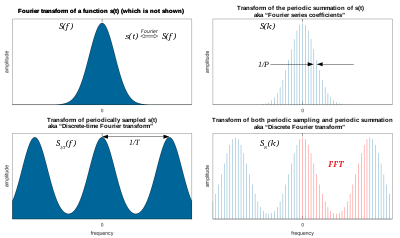Discrete Fourier transform converts a finite sequence of equally-spaced samples of a function into a same-length sequence of equally-spaced samples of the discrete-time Fourier transform, which is a complex-valued function of frequency. The interval at which the DTFT is sampled is the reciprocal of the duration of the input sequence. An inverse DFT is a Fourier series, using the DTFT samples as coefficients of complex sinusoids at the corresponding DTFT frequencies.
It has the same sample-values as the original input sequence. The DFT is therefore said to be a frequency domain representation of the original input sequence. If the original sequence spans all the non-zero values of a function, its DTFT is continuous (and periodic), and the DFT provides discrete samples of one cycle. If the original sequence is one cycle of a periodic function, the DFT provides all the non-zero values of one DTFT cycle.
The DFT is the most important discrete transform, use to perform Fourier analysis in many practical applications. In digital signal processing, the function is any quantity or signal that varies over time, such as the pressure of a sound wave, a radio signal, or daily temperature readings, sampled over a finite time interval (often defined by a window function).
Since it deals with a finite amount of data, it can implement in computers by numerical algorithms or even dedicated hardware. These implementations usually employ efficient fast Fourier transform (FFT) algorithms; so that the terms “FFT” and “DFT” are often use interchangeably. Prior to its current usage, the “FFT” initialism may have also been used for the ambiguous term “finite Fourier transform“.
How does Discrete Fourier Transform work?
The DFT does mathematically what the human ear does physically: decompose a signal into its component frequencies. If you extract some number of consecutive values from a digital signal — 8, or 128, or 1,000 — the DFT represents them as the weighted sum of an equivalent number of frequencies.
What is the use of discrete Fourier transform?
The Discrete Fourier Transform (DFT) is of paramount importance in all areas of digital signal processing. It is use to derive a frequency-domain (spectral) representation of the signal.
Need of FFT?
The “Fast Fourier Transform” (FFT) is an important measurement method in the science of audio and acoustics measurement. It converts a signal into individual spectral components and thereby provides frequency information about the signal.
What is purpose convolution?
Convolution is a mathematical way of combining two signals to form a third signal. It is the single most important technique in Digital Signal Processing. Convolution is important because it relates the three signals of interest: the input signal, the output signal, and the impulse response.
What are types of convolution?
Transposed Convolution (Deconvolution, checkerboard artifacts) Dilated Convolution (Atrous Convolution) Separable Convolution (Spatially Separable Convolution, Depthwise Convolution) Flattened Convolution.
Working of convolution?
The convolution is perform by sliding the kernel over the image, in general starts at the top left corner, so as to move the kernel through all the positions where the kernel fits entirely within the boundaries of the image.
What is a valid convolution?
A valid convolution is a type of convolution operation that does not use any padding on the input. This is in contrast to a same convolution. Which pads the n×n n × n input matrix such that the output matrix is also n×n n × n .
What is a transposed convolution?
Transposed convolution is also call as Deconvolution. Which is not appropriate as deconvolution implies removing the effect of convolution which we are not aiming to achieve. It is also call as upsampled convolution which is intuitive to the task. It is use for perform, i.e upsample the input feature map.
What is regular convolution?
Depthwise Convolution is a type of convolution where we apply a single convolutional filter for each input channel. In the regular 2D convolution performed over multiple input channels. The filter is as deep as the input and lets us freely mix channels to generate each element in output.





